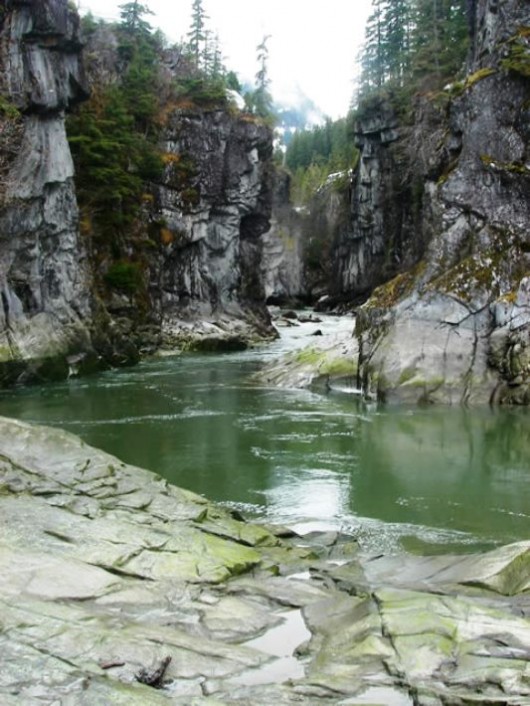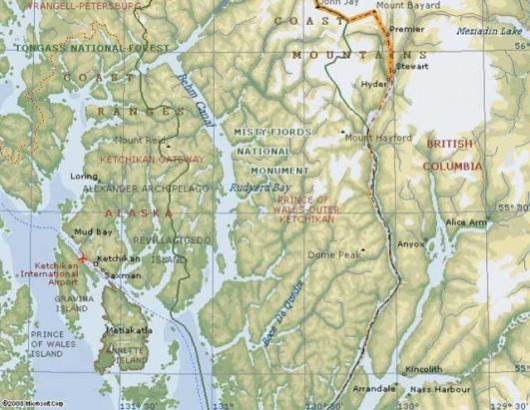Alaska Power and Telephone, through its subsidiary, Soule Hydro, is planning a multi-million-dollar hydroelectric project on the Tongass National Forest that would pump almost 80 megawatts of power into the Canadian and Lower 48 electric grid.
The company has filed for a Presidential Permit that would allow its planned underwater transmission cable to cross international borders, but some are not on board with the proposal.
Alaska Power and Telephone has been working on the Soule River dam project for quite some time. It kicked off the federal licensing process in 2005, and has continued efforts over the last eight years to make the 77.4-megawatt project happen.
Just for perspective, the total hydroelectric capacity for all of Ketchikan, which involves multiple dams, is about 34 megawatts, so roughly half the proposed Soule output.
A NEW EXPORT INDUSTRY
Jason Custer of AP&T said that one of the region’s most abundant renewable resources has the potential to become an important industry for Southeast.
“We’re trying to create a new energy export industry for Southeast, which is similar to oil and gas in more northern parts of the state,” he said. “The key different is this is renewable energy, and while we have a finite supply of oil and gas, the rain keeps coming every year. So this is an energy export project that we could have forever.”
LAND USE DESIGNATION HURDLE
Soule River is in Portland Canal just outside of the Misty Fiords National Monument. Locally, the area is called Glacier Bay, and while it’s not technically wilderness, its LUD, or Land Use Designation, under the Tongass Land Management Plan is remote recreation.
Two years ago, the U.S. Forest Service submitted comments about the project, stating that, as proposed, the Soule River dam would have “significant irreversible and irretrievable effects to the environment.” The comments recommended a full Environmental Impact Statement.
In addition, a 2011 letter from Tongass National Forest Supervisor Forrest Cole to AP&T’s Robert Grimm states that the Forest Service had no plans at that time to amend TLMP. Cole writes that AP&T shoulD “consider an alternative that is smaller in scale and effects, and that would be consistent with the remote recreation LUD direction.”
Cole’s office did not respond to a request for comment for this story.
Custer said it’s challenging to develop new hydro projects in Southeast because TLMP doesn’t include a LUD for renewable energy. AP&T and other groups have asked that the forest plan be updated to reflect that potential use.
A regional environmental group is directly opposed to the project, partly because the Soule River is a remote recreation site, and partly because the power will go Outside.
“I believe we should be focusing our energy on developing energy for our communities, and not focused on developing energy for mines being developed in (British Columbia),” said Lindsey Ketchel, executive director of the Southeast Alaska Conservation Council.
She said SEACC supports hydroelectric projects and other renewable energy proposals in general, just not this one.
“Our preference is that you work with communities like Kake and Hoonah and others where they’re paying 63 cents per kilowatt. Those individuals, those communities desperately need a fair rate,” she said.
There is the environmental impact to consider, too. While not against the project, the Alaska Department of Fish and Game identified some potential hurdles. During that same comment period a couple years ago, Monte Miller, the state hydropower coordinator for Fish and Game, wrote that salmon and Dolly Varden, a type of trout, could be affected by the project. The comments included recommendations for mitigation if the project moves forward. Miller confirmed via recent email that there has been no change, and the comments stand.
PUBLIC’S BEST INTEREST
Custer admits there would be some impact, especially during construction. He said that through the FERC licensing project, the government will consider the pros and cons. He contends that the environmental costs of not building the dam are high, and the project is in the public’s best interest.
The calculated carbon cost of an energy project is one of the factors considered by FERC, and Custer gave some numbers for the dam’s cost versus a natural gas plant with similar power output over about 50 years.
“Soule is going to save $609 million in social costs of carbon costs compared to a natural gas plant of the same size and with the same life span,” he said. “If we were able to develop Soule as an alternative to a coal-fired plant, we’re looking at $1.3 billion of social costs of carbon savings.”
AP&T’s proposal calls for a high-voltage, alternating-current transmission line that would originate at the Soule River, and continue to a substation in Stewart, British Columbia.
The Alaska portion of the project includes eight miles of cable that would be placed on the sea floor before crossing the border near Hyder. The cable then would continue under Canadian water for about two miles before landing at Stewart’s Arrow Dock. The overhead portion would travel about 2-and-a-half miles to the substation. The project needs to clear the Canadian permit process in addition to FERC’s.
POTENTIAL REGIONAL ECONOMIC BENEFIT
Custer touts the potential economic benefits for southern Southeast Alaska. The project will cost an approximately $330 million just to build.
“Going over to the operational period, there’s also going to be significant expenditures in Alaska to operate and maintain this project,” he said. “Those expenditures are going to resonate regionally.”
And locally: “Ketchikan, being the hub community for southern Southeast, and being the closest community of significant size to Hyder and the location of this project, stands to benefit significantly in terms of expenditures during construction and maintenance and operation of the project.”
Once built, hydroelectric projects also are inexpensive to operate. They are low maintenance, and don’t rely on fluctuating costs of, for example, coal.
If the presidential permit is approved, that doesn’t mean the project is good to go. It still needs the FERC license, which will require more studies, including various environmental assessments.
Comments on the presidential permit application will be accepted through Thursday, Aug. 29. Send comments to Brian Mills, Office of Electricity Delivery and Energy Reliability (OE–20), U.S. Department of Energy, 1000 Independence Avenue SW, Washington, DC 20585. His email is Brian.Mills@hq.doe.gov







